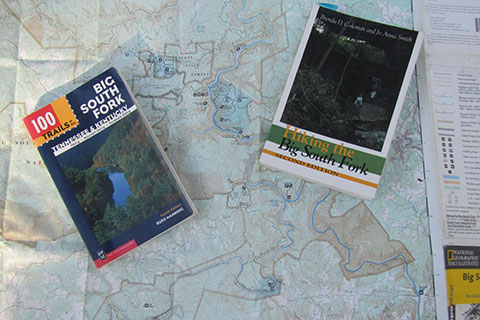| 724 | Self Rescue Plan Ahead |
2012-11-02 |

A poor plan is better than no plan at all.
The first step to Self Rescue on the Trails is to Plan Ahead. Bigger trips require more planning, but all trips require a certain degree of prior knowledge, if you want to reach your goal safely and avoid rescue.
A couple of examples ...
On a backpacking trip to Big South Fork, we consulted a map and guide books prior to our trip. We saw that our route was going to have to join Horse Trails for a section, and thought that would mean a nice wide path suitable for horses. Well, we found instead that the trail was wide, very wide, but all of it was a muddy mire a foot or more deep. The mile plus section of trail definitely took some of the fun out of the trip. The map did not say - caution mud ahead and the guide books did not mention the problem either, mainly because it was a seasonal issue. We were hiking in the spring. We did not ask about trail conditions while we were obtaining permits, nor did we check on-line for other hikers comments. So for our poor planning, surprise - have some mud!
While planning to climb Colorado's 54 14ers (2009), we designed a list specifying the order to climb the peaks that would reduce travel. We would go from one area to the next and climb all of those peaks in the area. The plan made a lot of sense, but the conditions in Colorado were not favorable for us completing the list as planned. There was way too much snow. As often as possible we checked for first hand knowledge of conditions on the ranges and modified our plan as needed. We ended up having to drive much further than expected. We had a good plan, but climbing in the early summer snow conditions was a lot of hard work (post holing) so we changed the plan to avoid the deep snows. So despite our thorough planning, surprise - the plan did not work. We had to spend more time driving and had less time resting. However, because we had spent so much time planning and preparing, we were able to change our schedule and still meet our friends who were joining us at various dates throughout the summer and to reach our final goal of climbing the 54 mountains.
A few planning thoughts ...
Once you decide where to go, find all of the information possible about the area and specific trail or route.
Check maps, guides, and online sources. For example: cloudhiking.com (our other site) has thorough information on some of trails and adventures. We include images from the trail, trail description, mileages, trail notes, GPS, and a map made for the adventure. There are many other sources too. If you have a question, ask. We wish we had asked about the mud!
Know the daily mileage, elevation gained, and the terrain.
Call or stop by the land manager's office and ask about current conditions. Most National Parks have good first hand knowledge. Heed their warnings and listen to their advice.
Obtain a long range weather forecast.
Know the dangers of your hike. What kind of wildlife are native? What are the weather extremes? What is the condition of the route? etc.
Pack, prepare, and train with regards to the knowledge you obtained through planning.
Plan together with everyone on the trip. Whether they want to actively plan or not, share the agenda with them, and ask for feedback.
Before you leave the trailhead, leave a detailed trip agenda with a responsible person. Include such important data as the land manager's contact information, departure time and date, return time and date, the intended route, planned campsites, color of gear - jackets, tents, etc., any other known issues, the probability of staying on schedule, and when late is late. Don't forget to "report in" when you return.
Never change the plans unless you are able to advise your contact person of the changes.
With mobile phones, it is easy to call a friend or relative and leave information, but it is also important to leave a hard copy - which of course may be emailed.
Planning for a trip extends the life of the trip because you engage in trip long before you leave the trailhead. Don't be surprised by the unexpected, hike safely and plan ahead!
Happy Planning Ahead trails
Down is Optional ... Up is Mandatory - introduction
Self Rescue on Trails - the program
Self Rescue - Plan Ahead - plan to prevent
Self Rescue - Be Kind to Yourself - don't make it hard, make it easy
Self Rescue - Be a Lightweight - walk light and easy
Self Rescue - Avoid Huffing and Puffing - listen to your body and control your speed
Self Rescue - Take a Break - give your body a chance to recover
Self Rescue - No Food, No Fuel, No Fun - feed the motor
Self Rescue - Watch Your Time - always know your location, time, and speed